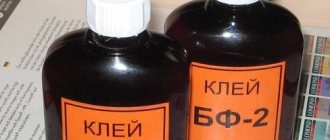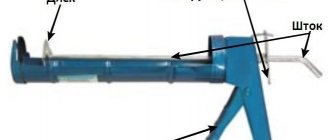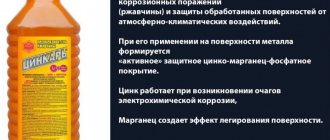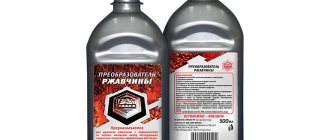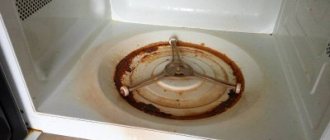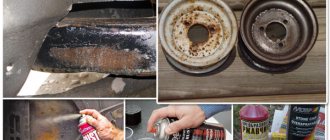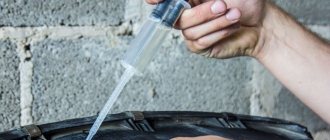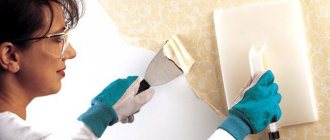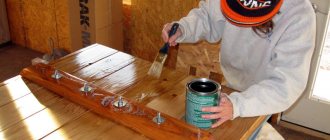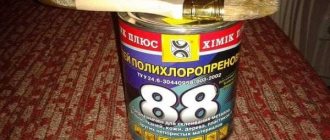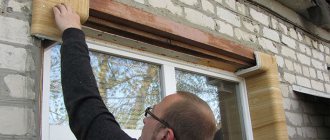Metal is durable, reliable, strong, but, unfortunately, it is susceptible to corrosive destructive processes. To protect the material from this harmful effect, various protection methods have been developed, which are divided into two groups:
- Electrochemical. Based on the creation of electrical potentials and galvanic steam, they involve the use of a more active metal that is subject to destruction, but protects the main structure.
- Conservation. These methods involve the formation of a protective layer that prevents corrosive factors from affecting the metal.
Each method has its positive and negative aspects. Electrochemical, as a rule, is used in conjunction with conservation, and not in its pure form. The advantages of both directions of protection are combined by a product such as Tsinkar, which appeared in 2002 and is becoming increasingly popular year after year.
Rust converter "Tsinkar"
The product, developed on the basis of zinc and manganese salts, and orthophosphoric acid, forms an active protective coating on the metal surface. Manganese compounds create an alloying effect, and zinc salts are activated when foci of electrochemical corrosion occur.
The action of the drug is based on the destruction of oxide forms of iron (rust), which are converted into phosphates, and the simultaneous occurrence of a reaction involving manganese and zinc. This allows you to obtain not only a protective, but also a strengthened layer. This efficiency is due to the competent redistribution and combination of components, which monophosphate formulations lack.
Compound
Let us tell you in detail what “Tsinkar” is for cars. This metal processing product, produced by the Moscow company Agat-Avto, is intended to remove pockets of corrosion on all types of metal surfaces and further protect them. It contains not only orthophosphoric acid, which can destroy the oxide layer (rust) in a short time, but also catalysts that accelerate the process, stabilizers, inhibitors, as well as zinc and manganese salts. The latter form a protective layer on the surface that prevents its further destruction. Zinc suppresses rust that has already appeared, and manganese alloys, that is, it strengthens the already formed protective layer.
“Tsinkar” is produced in canisters and bottles of different sizes:
- 60, 500 ml and 1 l;
- 0.5-liter containers with a sprayer; They are especially convenient for processing structures of complex shapes;
- 10 liter cylinders.
It is better to buy “Tsinkar” already with a sprayer. This container has a convenient streamlined shape and is comfortable to hold in your hand.
The product can also be applied before painting if there is no visible layer of rust. It will help protect the metal from destruction.
Just keep in mind that the Zinkar solution contains orthophosphoric acid, which is a highly aggressive agent. It should not be left on the surface. That is, after application, the unreacted solution must be thoroughly washed off the surface with plenty of water. Otherwise, the chemical reaction will continue, and the metal will be covered with an even greater layer of rust!
Efficacy of the drug
The presence of active components in the chemical composition of the rust-fighting agent “Tsinkar” makes it possible to achieve an efficiency that exceeds its value in comparison with other rust converters based on a monophosphate (consisting mainly of orthophosphoric acid) composition, more than twice. Active manganese and zinc form a durable layer of protection on the treated surface. After application to a steel surface, zinc localizes pockets of electrochemical corrosion, and manganese contributes to the alloying effect of the surface and strengthens the protective layer. Such a positive effect cannot be obtained by treating steel products with monophosphate compounds.
Consumption rates
The amount of material consumed directly depends on the application method and the device used for this. As a rule, a single application of the Tsinkar preparation per 1 m² of metal surface implies the consumption of 110-340 g of material.
Application area
The product is intended for metal processing, but it works best when coating steel, with the purpose of transformation - removing corrosive lesions, subsequent protection of coated areas and structures from atmospheric and climatic influences that lead to the formation of rust.
The Tsinkar converter is used to cover metal structures: roofs, vehicles, garages, supports (trusses) of overpasses and bridges, products with rivet type connections and welded seams. The drug is also used for domestic purposes. It is used to clean tools, steel fixtures and elements from corrosion.
How to avoid mistakes?
How to Avoid Failures
Sometimes it happens that after using the product, rust begins to appear again and again. Most often, this may be due to non-compliance with the technology, which is described in great detail in the instructions. For example, the stream from a cylinder may flow unevenly if you keep everything at a distance of less than 15 cm from the metal surface. Some people begin to forget to shake the solution before carrying out work, which is why it may begin to separate. When applying, the brush should be pressed against the base so that the treatment is more thorough and there are no unpainted areas.
Advantages and disadvantages
Such a drug has many advantages, and one of them will be the ability to use it for a wide range of products, ranging from various vehicles, as well as household devices and complex structures.
Other advantages are:
- Simplicity and ease of application.
- Low consumption and affordable cost.
- Availability of the composition in containers of different sizes.
- The ability to treat hard-to-reach areas and hidden cavities using a spray composition.
- No negative impact on parts and elements.
- High level of effectiveness against rust and to prevent its formation in the future.
But the product also has disadvantages. The application instructions must be strictly followed, otherwise you will not achieve the desired result. The composition will be suitable for early and medium degrees of metal corrosion, and in case of severe damage it is better to use a more reliable method, that is, welding. The composition is toxic, and you should work with it carefully, observing personal protection measures.
Result of use
The rust converter Tsinkar is one of the most effective products. When using it, areas of surface corrosion are practically dissolved with the transition of oxides to phosphates. A protective zinc-manganese film will also be created on the metal, which will protect the product from future rusting.
Release form and consumption rate
Anti-rust agent “Tsinkar” is available in several versions:
- regular bottles with caps with a capacity of 60, 500, 1000 ml;
- modified half-liter bottles with a sprayer;
- 10 liter canisters.
The shape of the container affects ease of use. If you plan to coat products with a complex configuration or a hard-to-reach area, it is better to choose a bottle equipped with a trigger (spray) that allows you to evenly treat the entire surface.
The amount of material consumed is influenced by two factors: the method of application and the number of layers. To purchase the required amount of the composition, you need to know that for a single application on each square meter of a metal surface, from 110 to 340 grams are required.
Advantages of the drug
In comparison with other methods of combating corrosion, the use of the drug “Tsinkar” guarantees the user the following advantages:
- uniform distribution of the composition over the treated steel surface, which guarantees economical material consumption and processing efficiency;
- the presence of a sprayer provides the ability to treat hard-to-reach surfaces and hidden cavities;
- the product does not contain flammable or combustion-supporting components;
- ease of use and its very reasonable cost.
Instructions for use
“Tsinkar” is most often used by car enthusiasts. The vehicle owner can entrust the anti-rust treatment to service station professionals or do the entire job themselves. It is better to know how to use this product, since it may be necessary to get rid of corrosion on metal not only on a car, but also on other steel structures.
Even a beginner will not have any particular difficulties with applying the drug. This work does not require any special skills, specialized tools or materials. The main thing is to take precautions, since the composition is a fairly caustic substance, and to follow a clear sequence of actions.
Types of rust modifiers
The industry produces rust converters for the following types of cars:
- Zinc. All zinc-based preparations are popular. The deposited layer of zinc on the car body prevents the recurrence of corrosion. Before performing the operation, the rusty surface is cleaned, sanded and treated with an electrolytic zinc solution. Experts note that the optimal time for applying a zinc rust converter is the moment a gray coating appears on the metal.
- Acidic. Such preparations prevent the development of corrosion at the initial stage. This is important because the car body is usually made of thin metal. If the rust process is started, the part quickly rots and through corrosion can form. As a result, expensive elements will have to be replaced. If a section of the body is coated with this modifier, a layer of corrosion simply will not form and the driver will not have to change the fender liners or hood cover over time.
- Converters of rust into soil. These are new generation modifiers. Unlike products produced on the basis of orthophosphoric acid, they do not create a protective layer on the metal, but convert rust into a primer. These primers are popular abroad, but in Russia, car enthusiasts tend to choose between products based on zinc or acids.
We recommend: Cold welding for metal: instructions and application features
Surface preparation and converter application
The product cannot be applied to the surface without first cleaning the metal from loose, flaking rust. To remove, you can use absolutely any abrasive product without any restrictions. You can use a metal brush and other tools. This also applies to painted surfaces. You definitely need to get rid of the old paint.
The container in which Tsinkar is sold is opaque, so the consumer cannot see that a residue is forming at the bottom. To ensure that the mixture is completely ready for use, the bottle or canister must be shaken thoroughly and only then used. If the converter has a trigger, then it is applied by spraying. In other cases, use a roller or brush.
How long does it take for Tsinkar to dry?
Many car enthusiasts are concerned about how long Tsinkar will dry out. It all depends on how many times the surface has been treated and what the ambient temperature is. In sunny weather and a temperature of about 20 degrees Celsius, the process will take no more than 30-40 minutes.
After making sure that the surface to be treated is completely dry, you need to remove the remaining solution as thoroughly as possible. If this is not done, you can achieve a completely undesirable effect when, under the remnants of the drug, the rust “blooms” in an even more magnificent color!
Terms of use
Re-processing of the metal surface is allowed only after the first layer has completely dried. This is evidenced by the formation of a whitish or grayish coating. Go over it with a stiff hair brush. This allows you to get rid of unreacted elements of the composition and prepare the coating for the next cycle.
Each new layer enhances the physical and chemical qualities of the anti-corrosion coating, guaranteeing reliable protection against external factors that lead to rust. The number of applications carried out has no restrictions.
You should refrain from the desire to save the converter. It is not recommended to limit yourself to one layer, especially when the product is used in critical areas and structures.
The best option is to carry out two treatments. If the product is needed only to get rid of rust, but not to extend the life of a metal product, one coating will be enough.
Reviews of the chemical product “Tsinkar”
There are different opinions about the effectiveness of this rust converter; extremely negative reviews are mainly left by those users who used the composition in violation of the technology, who were too lazy to properly treat the surface before and after using “Tsinkar”. Like any product, the Russian product has its advantages and disadvantages, but its main advantage is that it is inexpensive, practically not inferior in quality to foreign analogues.
Andrey, Moscow. I first noticed this drug while watching my friend clean steel rims by spraying liquid from the bottle. The rust melted before our eyes, and a matte, uniform surface appeared in its place. Now, before painting, I always use Zinkar, even if the metal is not too dusty. I believe that every car enthusiast should have such a tool, and in general it will always come in handy in the household. I didn’t find any disadvantages, pluses – it cleans the surface perfectly, low price.
Alexey, Nakhabino. I’ve been using Tsinkar for several years now, mainly using it to remove rust on a car body. I won’t say that this is a super magical remedy, but it helps, although not in all cases and not for very long. After applying the composition, a violent reaction occurs with hissing and the appearance of bubbles; I always process metal parts several times.
It is almost never possible to completely get rid of corrosion, but the rusting process can be stopped. Personally, it seems to me that the price is somewhat overpriced, and you shouldn’t believe the advertising promise; it’s better to pay special attention to the preparation for painting.
Maxim, Belarus. I work with Tsinkar when cleaning pipes and sheet metal, I use it even in cases where I don’t see any traces of rust. What you definitely need to do is rub in the composition with a brush, even if you use a sprayer. After treating with liquid, we must prime the metal, but before that it is very important to let the iron dry thoroughly. I rarely use the product for cars; I prefer more expensive auto chemicals.
Yuri, Moscow. I don’t know how it is for anyone, but I didn’t like this “miracle” remedy. Immediately after treatment, white dots appeared, and six months after painting, rust began to appear in the same place again. It is interesting that the manufacturer does not report anything about the guaranteed duration of the drug; apparently, the developers themselves do not know how effective this liquid is. Of course, “Tsinkar” is inexpensive, but time is wasted and money wasted.
Vlad, Moscow. For my car, I first bought a small bottle of the product (60 ml), because I didn’t really believe the advertising promises, it turned out that it was in vain. First, as an experiment, I cleaned the rust from the old nut, after processing it began to look like new. Now I use the drug constantly, I think that it justifies its cost many times, I use it to remove “saffron milk caps” on the body of a car.
Final processing of the converter
When work with the product is completed, you need to wait until it is completely dry, then wipe it with a rag or dry cloth. Next, the drug can be washed off. This depends on further actions with the treated surface.
The application of paint and varnish material after a cycle of work with the Tsinkar rust converter is carried out in full compliance with the requirements for the composition that is supposed to be applied. In other words, this anti-rust agent does not affect further priming or painting of metal elements, parts and structures.
How to avoid possible failures
It happens that after using the product, rust appears again. Most often, the fault is non-compliance with the technology, which is described in detail in the instructions. For example, a spray from a can may flow unevenly if you hold it at a distance of less than or more than 15-20 cm from the surface. Some people forget to shake the solution before use, which can cause it to separate. When applying, the brush must be pressed firmly against the base so that the treatment is more thorough and there are no unpainted areas left.
Washing off the rust converter “Tsinkar”
By “washing” we mean removing the dense gray-white or white protective anti-corrosion coating formed by the converter. It can be removed using silicone remover, white spirit or plain water. The plaque is wiped off with a sponge soaked in liquid. It should be slightly damp. No excessive effort is required.
It is better not to touch particles of the product that were not erased during the rinsing process. They are a kind of crystalline conversion layer that prevents metal corrosion. It is recommended to proceed with further priming or painting only after the top layer of the converter has completely dried. Otherwise, it may react with the subsequently applied composition. Considering that when painting, the plaque will be invisible, some craftsmen do not remove this layer at all.
If the surface after treatment is not intended to be covered with paint and varnish material, then washing must be carried out. Otherwise, the treated structure or area will not look quite presentable.
Priming and protecting the body after using the converter
To reduce the cost of future body repairs, good protection should be used. Immediately after treatment with this product and drying of the body parts, welding work can be carried out. It is important to treat all exposed areas so that they do not rust or deteriorate over time. During the processing process, fairly simple and effective solutions are used. After treatment with Zinkar, protection is performed as follows:
- a primer should be applied to all treated surfaces of the car, choosing a good protective material;
- when applying, it is important to remember the need to apply additional protective materials on top;
- if we are talking about external external parts, priming and subsequent painting must be done in a chamber;
- if the body is not properly dried before priming, it will not be possible to properly treat and protect the surface;
- The quality of the primer must be very high, since already damaged parts easily rust at the first opportunity.
Of course, a rust converter is not a panacea. Rather, this is one of the possible emergency methods of solving the problem. In most situations, service technicians prefer to carry out welding work. This ensures higher quality and good reliability of repairs. However, welding areas should also be treated to protect against corrosion. In any case, repair areas have a high risk of damage in the near future.
Security measures
The Tsinkar converter contains orthophosphoric acid. This substance is classified as flammable and explosive. Treatment with preparations containing phosphoric acid is carried out in a room with high-quality ventilation, thoroughly ventilated after all manipulations.
Work must be carried out with gloves, using personal protective equipment for respiratory and visual organs. The place of contact, if the substance gets on the mucous membrane or skin, is washed abundantly with running water. When the burning sensation and redness do not go away, you should immediately seek medical help.
Anti-rust agent "Tsinkar" is not flammable. And if you follow all precautions, it will not pose any danger. It must be stored, like any other chemical, in places inaccessible to children.
Main varieties
If we talk about such means, then, first of all, we should highlight the following types:
- rust converter with zinc. At the moment, such substances are the most popular. They are characterized by almost instantaneous action and high efficiency. They offer increased protection against further rust. At the same time, before using them, you need to treat the surface with sandpaper, and then with a zinc solution. The product itself is used when the surface acquires a gray tint. It will take you longer than with other remedies, but it's worth it;
It may also be interesting: The alarm does not respond to the key fob, what should I do?
- acid agents. An old and proven method that is extremely useful and effective. The main advantage is simplicity and speed of use. We simply clean the area where rust has developed, and then apply the solution there. It is important to calculate the time correctly so as not to overexpose the product, but also not to eliminate it in advance. In general, here you need to follow the instructions;
- rust converter into soil. This is a fairly new modification that helps transform corrosion into soil. At the same time, according to reviews, the use of such solutions is not the safest idea, because the substance can damage the paintwork near the source of corrosion.
We recommend: Tire side cut: repair or replacement?
